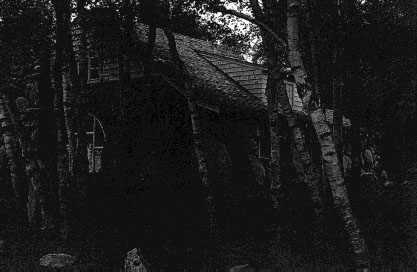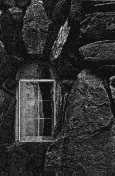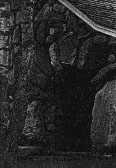Previous Article • Next Article
Article Index • Charlevoix History Main Page
|
Michigan Natural Resources, September/October 1994 THE MAN WHO LOVED STONESby Ingrid Tomey, photos by Larry Tracy, Jr.
Some people call it "Smurfville," others call them "Fairy Houses." But, by any name, the stone houses of Charlevoix are an amazing legacy of one of Michigan's most fascinating builders. Earl Young grew up in Charlevoix, a Lake Michigan resort community of 4,000, and, like many of his playmates in the early 1900s, he walked the shorelines collecting interesting rocks. It was a pastime that grew into a passion -- one that changed the face of Charlevoix. Born in 1889, Earl Young became a Charlevoix Realtor; in the early 1920s he built a house -- a stone house -- for his new wife, Irene, and their growing family. The house was a prototype of sorts, for over the next half century, until his death in 1975, Young, with no formal training, built or remodeled 29 more of these picturesque dwellings. Some were round with thatched roofs, some sprawling and wrapped around with stone walls. They had quirky elfin chimneys and massive fireplaces, and they all seemed to sprout from the earth like rings of mushrooms. "He believed in tucking the house into the landscape," said his daughter, Virginia Olsen, 75, who also is a builder, living part time in Charlevoix. "Trees weren't torn down to make room for the house. He built according to the lot because it wasn't just a house to him. It was a work of art. Every part of it had to go together." This wedding of house and landscape is evident to even the most casual eye in the 12 homes along Lake Michigan that Young designated Boulder Park in the early '20s. The homes are situated along the lake or behind it, with windows tucked between stonework to take advantage of the view of the lake on one side and the sloping woods behind. Great leaning birches share lawns with giant oaks, and boulders skirt the lawns like rough, white hedges. The houses themselves are built from gray and white boulders, or sliced quarry stones stacked like tan dominoes top to bottom, fanning out like a hand of cards over doors and windows. One of the larger homes, a house Young originally built for his family as a summer house, is set in a grove of towering birch, with a cathedral arch of natural boulders framing the view of Lake Michigan. In the back yard is a stone playhouse which Young built for his four children, complete with a working fireplace. All the Boulder Park houses have a sturdy, big-shouldered look, even those with lime green grout or bright red trim. The roofs in these early homes hadn't evolved into the eyepopping shapes of his later designs but they delight the eye nonetheless. Some are as peaked as dunces' caps, others are low and rounded like Hansel and Gretel's cottage. All are topped by stone chimneys, dripping, like gray frosting, with cement. The evolution of Young's style is apparent in the later homes built closer to town. Here are the mushroom houses with the round, undulating roofs, built into the sides of hills, behind trees, some enclosed in stone walls that rise and fall like trampled fences. Whimsical as they seem, there is nothing careless here, nothing unplanned, according to Olsen who, as a child, accompanied her father on many of his jobs. "He would study the lot and go home and think and think about it. Then he'd sketch it with charcoal and have my mother draw it out for him. (Irene Young was a talented local artist.) His house was like a painting -- everything had to be just so. He had to build it the way he saw it." Building it the way he saw it meant that Young chose every stone to complement every other stone. Boulders, selected for color, size and shape, had to be meticulously set and sometimes held in place by cranes for two or three days while the mortar hardened. "He was an artist," Olsen said with a laugh, "but he wasn't always practical. Neither my father or mother cared anything about cooking, so the kitchens in all his houses were small. He didn't build them for other people. He built them for himself." As his style evolved, Young's houses became quirkier, reflecting more and more of his personal vision and less of the conventional, boxlike houses going up around him. Though his reputation as an architect was spreading throughout the country, Charlevoix residents didn't always know what to make of their resident eccentric. Barely five feet tall, with a shock of white hair and bottle-thick glasses, Young was instantly recognizable as he scoured the countryside for rocks and boulders, a six foot staff in one hand and a large poodle named Pamper at his heel. Sometimes it seemed that his affection for stone surpassed his affection for more animate neighbors. "Stones have their own personalities," he said on more than one occasion, "People say I'm crazy when I say so, but they really do." The history, the long creation of glacial stones weighing as much as 100 tons and dating back hundreds of millions of years, appealed to Young. He would chip off samples of his finds and send them to be identified and analyzed. Such was his romance with stone that, from time to time, Young "decorated" the city park with boulders he came across. The fact that not everyone in town agreed with his artistic vision had little effect. If he couldn't find an immediate site for his favorite stone, Young would hitch up a team of horses to haul it out of the ground and then bury it. Or drop it in the lake. Or hide it in the woods. One of his favorite stones, according to his daughter, was a nine-ton boulder that he found while doing some excavating in 1928. Twenty-six years passed before he had occasion to use it. "But he knew right where it was," Olsen said. "He got a crane, dug it up and it became the keystone to this wonderful fireplace." The wonderful fireplace is the most famous of four fireplaces at the Weathervane Inn, a restaurant overlooking the Pine River Channel in Charlevoix that Young converted from an old grist mill in 1954. The prized stone has become famous for its amazing resemblance to a map of Lower Michigan, including pink veined highway routes. Young's artistry is probably best appreciated by people ...
|


